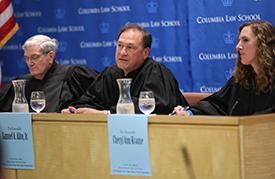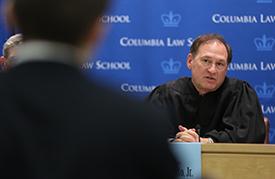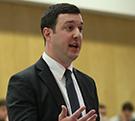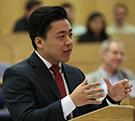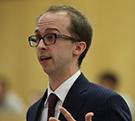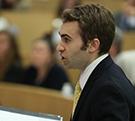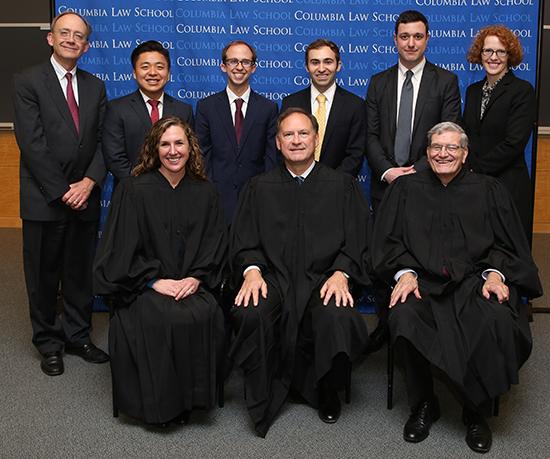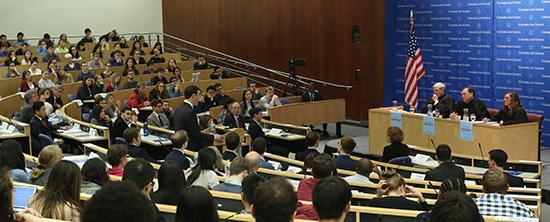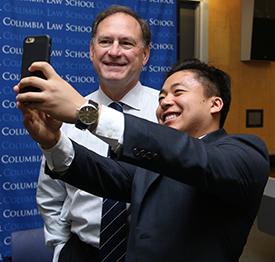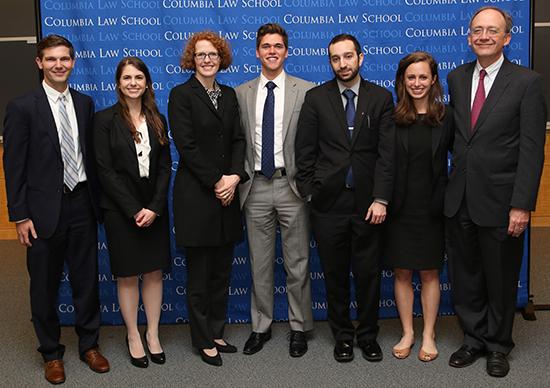U.S. Supreme Court Justice Samuel A. Alito, Jr. Praises Moot Court Competition Finalists
New York, April 14, 2016—Arguing a case before the U.S. Supreme Court is a formidable challenge for veteran lawyers, but four Columbia Law School students exhibited calm under pressure—and considerable skill—when they fielded probing questions and pointed comments from Associate Supreme Court Justice Samuel A. Alito, Jr. in the April 7 final arguments of the 2016 Harlan Fiske Stone Moot Court Competition.
Justice Samuel A. Alito, Jr. (center) and Judges José A. Cabranes and Cheryl Ann Krause question contestants in the final round of the April 7 Harlan Fiske Stone Moot Court Competition. |
The School last hosted a member of the Supreme Court in 2014, when Associate Justice Elena Kagan presided. In the past nine years, the competition has welcomed four of the eight sitting justices: Alito, Kagan, Associate Justice Sonia Sotomayor, and Chief Justice John Roberts.
| From left to right: Alexander N. Ely '16 and Timothy T. Kim '16, arguing for the plaintiff, face off against Logan J. Gowdy '16 and Aaron Michael Macris '16, arguing for the defendant. |
| The distinguished bench sits again, this time with student finalists, Harlan Fiske Stone Moot Court Faculty Director Philip M. Genty, and Dean Gillian Lester, at the end of the event. |
| Moot Court winner Alexander N. Ely '16 argues his case before the panel of distinguished judges as friends, family, faculty, and students look on. |
| Moot court finalist Timothy T. Kim '16 takes a "selfie" with Justice Samuel A. Alito, Jr. |
Organizers and participants are all smiles following the 2016 Moot Court competition. (From left to right: Jeffrey W. Coyle '16, semi-finalist and bailiff; Sydney A. Egnasko ’16, Harlan Fiske Stone Moot Court Co-director; Dean Gillian Lester; Steven M. LoCascio ’16, Director, First-year Foundation Moot Court Program; Michael-Anthony Jaoude ’16, Executive Director, Moot Court Program; Sarah Mac Dougall ’16, Harlan Fiske Stone Moot Court Co-director; Professor Philip M. Genty, Harlan Fiske Stone Moot Court Faculty Director) |
Post-Event Reception
Following the formal event, the judges took off their robes—and their game faces—as they mingled and posed for “selfies” with the competitors and their support teams during a celebratory reception. Gillian Lester, Dean and the Lucy G. Moses Professor of Law, congratulated and chatted with the competitors, and their families, while also engaging in private conversations with the judges.
